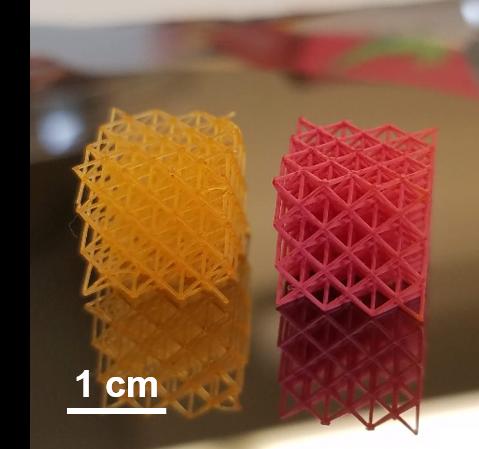A great new way to paint 3D-printed objects

A hydrogel lattice without (left) and with (right) coating. Credit: Jonathan P. Singer/Rutgers University-New Brunswick.
Rutgers engineers have created a highly effective way to paint complex 3D-printed objects, such as lightweight frames for aircraft and biomedical stents, that could save manufacturers time and money and provide new opportunities to create “smart skins” for printed parts.
The findings are published in the journal ACS Applied Materials & Interfaces.
Conventional sprays and brushes can't reach all nooks and crannies in complex 3D-printed objects, but the new technique coats any exposed surface and fosters rapid prototyping.
“Our technique is a more efficient way to coat not only conventional objects, but even hydrogel soft robots, and our coatings are robust enough to survive complete immersion in water and repeated swelling and de-swelling by humidity,” said senior author Jonathan P. Singer, an assistant professor in the Department of Mechanical and Aerospace Engineering in the School of Engineering at Rutgers University-New Brunswick.
The engineers discovered new capabilities of a technology that creates a fine spray of droplets by applying a voltage to fluid flowing through a nozzle. This technique (electrospray deposition) has been used mainly for analytical chemistry. But in recent decades, it has also been used in lab-scale demonstrations of coatings that deliver vaccines, light-absorbing layers of solar cells and fluorescent quantum dots (tiny particles) for LED displays.
Using their approach, Rutgers engineers are building an accessory for 3D printers that will, for the first time, allow automated coating of 3D-printed parts with functional, protective or aesthetic layers of paint. Their technique features much thinner and better-targeted paint application, using significantly fewer materials than traditional methods. That means engineers can use cutting-edge materials, such as nanoparticles and bioactive ingredients, that would otherwise be too costly in paints, according to Singer.
Next steps include creating surfaces that can change their properties or trigger chemical reactions to create paints that can sense their environment and report stimuli to onboard electronics. The engineers hope to commercialize their technique and create a new paradigm of rapid coating immediately after printing that complements 3D printing.
###
Rutgers co-lead authors are Dylan A. Kovacevich, a master's degree student, and Lin Lei, a doctoral student in Singer's lab. Other Rutgers co-authors include doctoral student Daehoon Han (currently a postdoc at the University of Minnesota), Christianna Kuznetsova, an undergraduate student and Professor Howon Lee. A researcher at the Massachusetts Institute of Technology contributed to the study.
Media Contact
All latest news from the category: Materials Sciences
Materials management deals with the research, development, manufacturing and processing of raw and industrial materials. Key aspects here are biological and medical issues, which play an increasingly important role in this field.
innovations-report offers in-depth articles related to the development and application of materials and the structure and properties of new materials.
Newest articles

Physicists ‘bootstrap’ validity of string theory
NYU and Caltech scientists develop innovative mathematical approach to back existence of long-held framework explaining all physical reality. String theory, conceptualized more than 50 years ago as a framework to…

Hyperspectral imaging lidar system achieves remote plastic identification
New technology could remotely identify various types of plastics, offering a valuable tool for future monitoring and analysis of oceanic plastic pollution. Researchers have developed a new hyperspectral Raman imaging…

SwRI awarded $26 million to develop NOAA magnetometers
SW-MAG data will help NOAA predict, mitigate the effects of space weather. NASA and the National Oceanic and Atmospheric Administration (NOAA) recently awarded Southwest Research Institute a $26 million contract…



